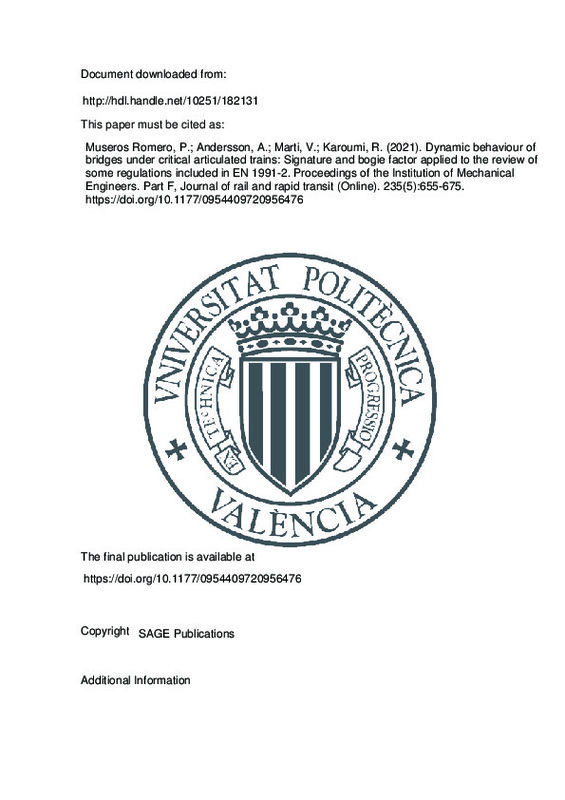Museros Romero, P.; Andersson, A.; Marti, V.; Karoumi, R. (2021). Dynamic behaviour of bridges under critical articulated trains: Signature and bogie factor applied to the review of some regulations included in EN 1991-2. Proceedings of the Institution of Mechanical Engineers. Part F, Journal of rail and rapid transit (Online). 235(5):655-675. https://doi.org/10.1177/0954409720956476
Por favor, use este identificador para citar o enlazar este ítem: http://hdl.handle.net/10251/182131
|
Título:
|
Dynamic behaviour of bridges under critical articulated trains: Signature and bogie factor applied to the review of some regulations included in EN 1991-2
|
|
Autor:
|

 Museros Romero, Pedro
Andersson, Andreas
Marti, Victor
Karoumi, Raid
Museros Romero, Pedro
Andersson, Andreas
Marti, Victor
Karoumi, Raid
|
|
Entidad UPV:
|
Universitat Politècnica de València. Departamento de Mecánica de los Medios Continuos y Teoría de Estructuras - Departament de Mecànica dels Medis Continus i Teoria d'Estructures
|
|
Fecha difusión:
|
|
|
Resumen:
|
[EN] The information contained in this paper will be of interest not only to bridge engineers, but also to train manufacturers. The article provides practical insight into the degree of coverage of realarticulated trains(ATs) ...[+]
[EN] The information contained in this paper will be of interest not only to bridge engineers, but also to train manufacturers. The article provides practical insight into the degree of coverage of realarticulated trains(ATs) that Eurocode EN1991-2 guarantees. In both the design of new railway bridges, as well as in the assessment of existing ones, the importance of a detailed knowledge of thelimits of validityofload modelscannot be overemphasised. Being essential components of the rail transportation system, the capacity of bridges to withstand future traffic demands will be determined precisely by the load models. Therefore, accurate definition of the limits of validity of such models reveals crucial when increased speeds and/or increased axle loads are required by transportation pressing priorities. The most relevant load model for a significant portion of the bridges in high-speed railway lines is the so-called HSLM-A model, defined in EN1991-2. Their limits of validity are described in Annex E of such code. For its singular importance, the effects of vibrations induced by HSLM-A are analysed in this paper with attention to the response ofsimply supported bridges. This analysis is carried out in a view to determine whether the limits of validity given in Annex E of EN1991-2 cover the largest part of cases of interest. Specifically, the vibration effects of HSLM-A are compared with those of the ATs described in such Annex E, and the response is analysed in depth for simply supported bridges, which are structures especially sensitive to passing trains at high speeds. New theoretical approaches have been developed in order to undertake this investigation, including a novel, simplified expression of thetrain signaturefor ATs that is convenient for its low computational cost. The mathematical proofs are included in the first part of the paper and two separate appendices.
[-]
|
|
Palabras clave:
|
Modelo de carga
,
Tren de alta velocidad
,
Línea de influencia dinámica
,
Impronta de tren
,
Sub-resonancia, Resonancia de orden superior
,
Espectro del bogie
,
Empate del bogie
,
Aceleración acumulada
,
Load model
,
High-speed train
,
Dynamic influence line
,
Train spectrum
,
Sub-resonance
,
Higher-order resonance
,
Bogie spectrum
,
Bogie wheelbase
,
Cumulative acceleration
|
|
Derechos de uso:
|
Reconocimiento - No comercial - Sin obra derivada (by-nc-nd)
|
|
Fuente:
|
Proceedings of the Institution of Mechanical Engineers. Part F, Journal of rail and rapid transit (Online). (eissn:
2041-3017
)
|
|
DOI:
|
10.1177/0954409720956476
|
|
Editorial:
|
SAGE Publications
|
|
Versión del editor:
|
https://doi.org/10.1177/0954409720956476
|
|
Agradecimientos:
|
The author(s) disclosed receipt of the following financial support for the research, authorship, and/or publication of this article: This research was partially developed during a stay performed by Pedro Museros at the KTH ...[+]
The author(s) disclosed receipt of the following financial support for the research, authorship, and/or publication of this article: This research was partially developed during a stay performed by Pedro Museros at the KTH Royal Institute of Technology, within the Division of Structural Engineering and Bridges (Stockholm, Sweden). The financial support of the Generalitat Valenciana, through the program BEST2019 for research stays (Subvenciones para estancias de personal investigador doctor en centros de investigacion radicados fuera de la Comunitat Valenciana), as well as the permission obtained from the Universitat Politecnica de Valencia to carry out such stay, are gratefully acknowledged.
[-]
|
|
Tipo:
|
Artículo
|







![[Cerrado]](/themes/UPV/images/candado.png)


